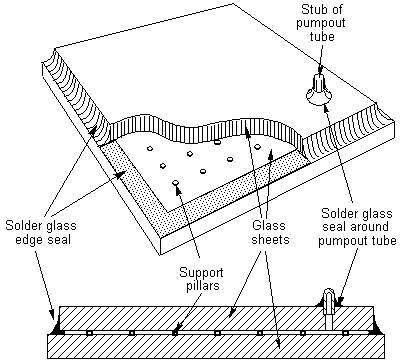

|
Vacuum glazing is a transparent thermal insulator with applications in energy efficient windows. It consists of two sheets of glass separated by a narrow evacuated space. The concept of vacuum glazing operates on the same principles as the conventional Dewar flask - the vacuum eliminates conductive and convective heat flow due to gas between the two glass plates, and internal low emittance coating reduces radiative heat transport to a low level. The thermal insulating performance of windows is very important in the design of energy efficient buildings. Since windows are considerably less insulating than the other components of surrounding building structure, they play an important role in energy consumption. The design and manufacture of vacuum glazing Vacuum glazing consists of two flat sheets of glass hermetically sealed together around the edges, and separated by a narrow (~0.15 mm) evacuated space (see figure). Under the influence of atmospheric pressure, the internal surfaces of the glass sheets are kept apart by an array of small support pillars which are high strength material such as metal (stainless steel or Inconel 718) or ceramic (alumina or zirconia). The actual glazing
is made from two sheets of soda-lime glass. The glass sheets, typically
3 mm thick, are separated by a large number of small support pillars.
The edge seal around the glazing periphery is made from solder glass,
which is a low melting point glass with a coefficient of thermal
expansion matching that of the soda-lime glass. The sample is evacuated
through the small pumpout tube, which is sealed to the outer surface
of the upper glass sheet with solder glass. The internal space is
evacuated to a pressure of about 10-4 Torr. After completion of
the evacuation and outgassing process, the end of the pumpout tube
is melted and sealed.
Research on vacuum glazing The Department of Applied Physics in the University of Sydney was the first institution in the world to produce thermally insulating samples of vacuum glazing. This occurred in 1988. We have since made very substantial progress on the science and technology of these devices. Over the years,
research has been done on various aspects of vacuum glazing. Over
1000 samples of vacuum glazing, with dimensions up to 1 m x 1 m,
have been made at the University of Sydney using constructions similar
to that shown in the figure above. Research has focused on
The University of Sydney vacuum glazing is being developed commercially in Japan under a licensing agreement. The technology has the potential to achieve substantial energy savings in buildings. For further information on vacuum glazing project, please contact Dr. Nelson Ng, nelson@physics.usyd.edu.au
|
